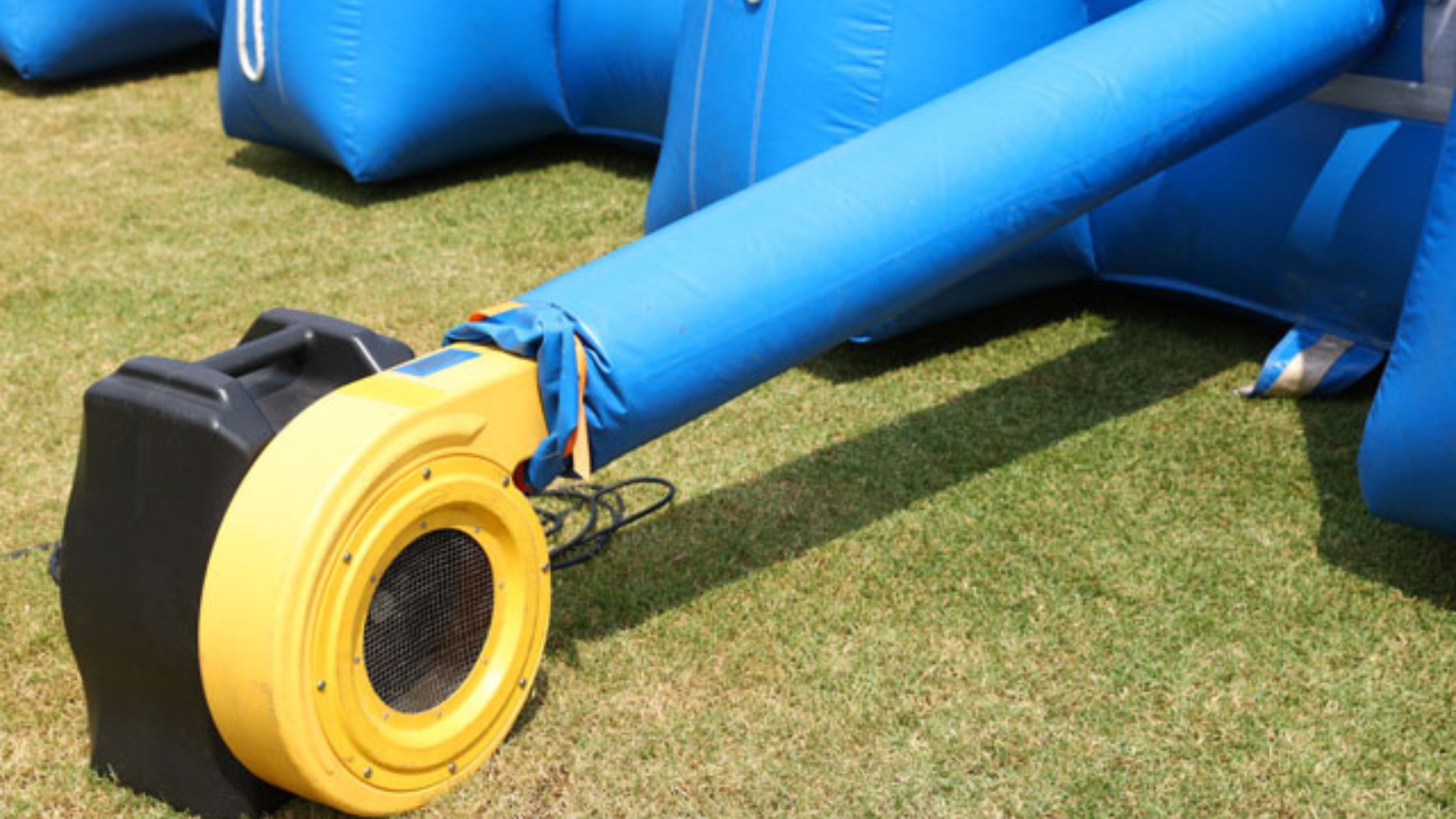
A bounce house is a staple at many parties, festivals, and family gatherings, providing children with hours of fun and entertainment. However, the excitement of the inflatable fun wouldn’t be possible without one essential piece of equipment: the bounce house blower. This powerful device is responsible for inflating the bounce house and maintaining its structure while children jump and play inside. Whether you’re renting a bounce house for an event or purchasing one for personal use, understanding how a bounce house blower works, how to choose the right one, and how to maintain it is crucial for a successful and safe experience.
In this article, we will explore everything you need to know about bounce house blowers, including their function, types, maintenance tips, and frequently asked questions.
Table of Contents
What is a Bounce House Blower?
A bounce house blower is an electric fan used to inflate and maintain the shape of a bounce house. This device pushes air into the inflatable structure, ensuring it stays inflated throughout the duration of the event. Unlike traditional air mattresses or inflatable toys that can be inflated and deflated manually, bounce houses require a continuous airflow to remain fully inflated. This is where the bounce house blower comes in.
The blower is typically connected to the bounce house through a hose, which directs the air into the inflatable. Most models are designed to work continuously, meaning the blower should be left on throughout the event to keep the bounce house properly inflated.
How Does a Bounce House Blower Work?
A bounce house blower operates using a basic principle of air circulation. The blower draws in air from the surroundings and pushes it into the bounce house through a large tube. This constant airflow helps maintain the pressure inside the inflatable, preventing it from collapsing.
The blower doesn’t necessarily “inflate” the bounce house in the traditional sense of adding pressure; instead, it provides a continuous flow of air that keeps the bounce house inflated. The design of the bounce house allows for a slight escape of air from the seams and vents, which is normal and necessary. The blower ensures that the bounce house stays at the correct level of inflation to support jumping and movement inside.
While the blower works continuously, the bounce house is designed to handle the flow of air without overinflating. The blower may have a built-in automatic cut-off or a variable speed control to prevent the bounce house from getting too tight or too loose.
Types of Bounce House Blowers
There are several different types of bounce house blowers available, and each has its own features and specifications to meet different needs. The two main categories of blowers are continuous blowers and heavy-duty blowers.
1. Continuous Duty Blowers
These blowers are designed to operate for long periods without overheating. They are the most commonly used for residential bounce houses and small to medium-sized inflatable structures. Continuous duty blowers are powerful enough to keep an inflatable bounce house inflated for hours at a time and are typically quieter than their heavy-duty counterparts. They are perfect for birthday parties, backyard events, and other short-term gatherings.
Key Features:
- Designed for long-term operation.
- Quiet and efficient.
- Ideal for smaller or medium-sized inflatables.
- Lightweight and portable.
2. Heavy-Duty Blowers
Heavy-duty blowers are more powerful and are often used for larger commercial bounce houses, inflatable obstacle courses, or other high-demand applications. These blowers are engineered to handle large, industrial-sized inflatables, offering significantly higher air output and pressure. They are designed to run continuously and handle the intense workload required for large-scale events such as carnivals or festivals.
Key Features:
- Higher airflow and pressure.
- Built for commercial-grade use.
- More durable and robust.
- Ideal for larger inflatables or multiple bounce houses.
How to Choose the Right Bounce House Blower
Selecting the right blower for your bounce house depends on several factors, including the size of the inflatable, the type of event, and the specific requirements of the manufacturer. Below are some essential factors to consider when choosing the right blower.
1. Size of the Bounce House
The size of the bounce house is perhaps the most important factor when choosing a blower. Smaller bounce houses, such as those designed for home use or kids’ parties, require less power, and a continuous duty blower is typically sufficient. Larger commercial-grade bounce houses or those with water slides or obstacle courses need more power and would require a heavy-duty blower.
Make sure to check the manufacturer’s recommendations for the required blower power, which is usually specified in horsepower (HP).
2. Power Rating (Horsepower)
The power of a blower is measured in horsepower (HP), and this determines how much airflow the blower can generate. A typical residential blower has a power rating of 0.5 HP to 1.5 HP, while commercial blowers may have power ratings as high as 2 HP or more. Higher horsepower typically means more air movement and better performance for larger inflatables.
3. Voltage and Amperage
Bounce house blowers come in different voltage ratings, typically 110V or 220V. The voltage requirements of the blower should match the available power source at your event location. For most home use, 110V blowers are common, but for large commercial setups, a 220V model might be necessary.
Additionally, check the amperage to ensure the blower doesn’t overload the electrical circuits. A higher amperage blower may require a dedicated power source or circuit.
4. Portability and Storage
If you plan on transporting the blower to different events, portability is an important consideration. Lightweight, compact blowers are easier to move around and store, while larger commercial blowers may require more space and additional handling. Check the weight and dimensions of the blower to ensure it’s practical for your needs.
5. Noise Level
Blowers can be noisy, especially heavy-duty models. Consider the noise level if you are hosting an event in a residential area or in a location with noise restrictions. Look for blowers that are designed with noise reduction features or select a continuous duty blower, which tends to be quieter than commercial models.
Maintenance and Care of a Bounce House Blower
To ensure your bounce house blower operates efficiently and lasts for years, proper maintenance is essential. Here are some tips for maintaining and caring for your blower:
- Regular Cleaning: Periodically clean the blower to prevent dust and debris from clogging the vents and air intake. Use a vacuum or air compressor to remove dirt from the blower. Ensure the air intake and exhaust areas are clear for optimal airflow.
- Inspect for Damage: Before every use, check the blower for any visible damage such as cracks, loose parts, or exposed wires. If you find any issues, address them immediately to prevent malfunction during operation.
- Store Properly: Store your blower in a dry, cool place to avoid exposure to moisture, which could lead to rusting or damage to electrical components. When storing the blower, ensure that it is disconnected from any power source.
- Check the Air Filter: Some blowers come with an air filter to prevent dust and dirt from entering the motor. Clean or replace the air filter regularly to maintain the blower’s performance and prevent overheating.
- Keep the Power Cord Safe: Always check the power cord for any signs of fraying, cuts, or other damage before use. Avoid using the blower with a damaged power cord, as this can pose a safety risk.
Frequently Asked Questions (FAQs)
1. How long can I run a bounce house blower?
Bounce house blowers are designed for continuous operation. As long as the blower is functioning properly and kept in a well-ventilated area, it can run for hours without issue. However, it’s important to take breaks during long events to ensure the blower doesn’t overheat.
2. Can I use a regular fan as a bounce house blower?
Regular fans are not powerful enough to inflate a bounce house. Bounce house blowers are specially designed to provide the consistent and powerful airflow needed to keep the inflatable structure properly inflated.
3. How do I know what size blower I need for my bounce house?
Check the manufacturer’s specifications for your bounce house, which should list the recommended blower size. For most residential inflatables, a blower with 0.5 HP to 1.5 HP will be sufficient, while commercial-grade inflatables may require a blower with more power.
4. Is a bounce house blower safe to use?
Yes, bounce house blowers are safe when used correctly. Always follow the manufacturer’s instructions for setup and maintenance, and ensure that the blower is properly secured during use. Keep the area around the blower clear to prevent overheating.
5. How much power does a bounce house blower consume?
The power consumption of a bounce house blower varies depending on its size and power rating. Most residential blowers use around 5-7 amps of electricity, while commercial models may use up to 12-15 amps.
Conclusion
A bounce house blower is a crucial piece of equipment for ensuring your inflatable stays properly inflated throughout the duration of your event. Whether you’re hosting a birthday party in your backyard or organizing a large festival, choosing the right blower for your bounce house can make all the difference. By understanding the various types of blowers, selecting the appropriate model for your needs, and properly maintaining the equipment, you can ensure a safe and enjoyable experience for everyone involved.





